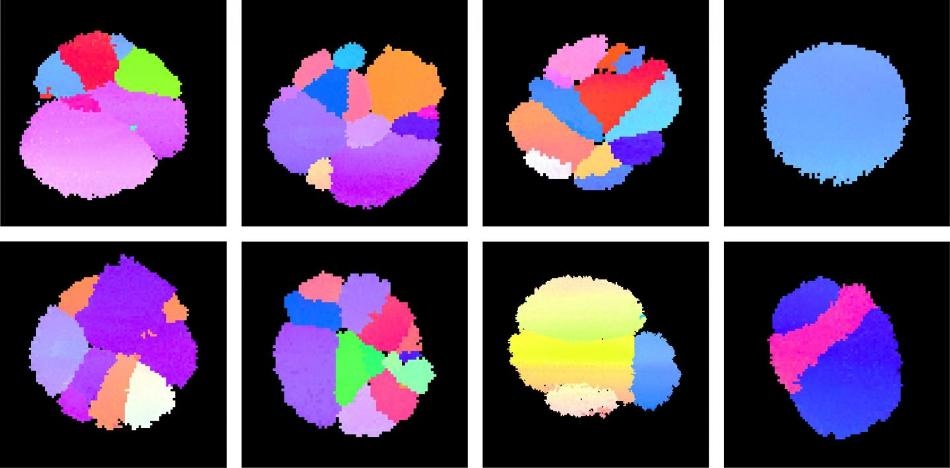Oct 24 2017
A technique that enables mapping of individual responses of nanoparticles in distinctive contexts and situations has been developed by Scientists at Chalmers University of Technology and the Technical University of Denmark. The outcomes of the study, recently reported in the Nature Communications journal, open the door for safer nanotechnology and better nanomaterials.
 Svetlana Alekseeva and co-workers have produced maps of individual nanoparticles. The eight images show eight different nanoparticles of the same substance, palladium. Each nanoparticle consists of a number of grains, which are displayed as different colored fields on the images. The properties and response patterns of the various grains differ, and these in turn determine the properties and responses of the nanoparticles when they come into contact with other substances. CREDIT: Svetlana Alekseeva.
Svetlana Alekseeva and co-workers have produced maps of individual nanoparticles. The eight images show eight different nanoparticles of the same substance, palladium. Each nanoparticle consists of a number of grains, which are displayed as different colored fields on the images. The properties and response patterns of the various grains differ, and these in turn determine the properties and responses of the nanoparticles when they come into contact with other substances. CREDIT: Svetlana Alekseeva.
In the years to come, nearly all innovative technology will be dependent on nanotechnology in some or the other way. However, nanoparticles are highly unpredictable. Although they seem to be the same when viewed from far away, each individual nanoparticle has distinctive properties when observed keenly.
Svetlana Alekseeva and Christoph Langhammer from Chalmers University of Technology in Sweden collaborated with Scientists from the Technical University of Denmark and found out the reason behind the distinctive behavior of different polycrystalline nanoparticles upon interaction with hydrogen. Such an understanding is vital in designing superior hydrogen detectors anticipated to play a significant part in the safety of hydrogen cars.
Our experiments clearly showed how the reaction with hydrogen depends on the specifics of the way in which the nanoparticles are constructed. It was surprising to see how strong the correlation was between properties and response—and how well it could be predicted theoretically.
Svetlana Alekseeva, Postdoc, The Department of Physics, Chalmers University of Technology
A nanoparticle of a certain material is comprised of a number of smaller grains or crystals. The total number of grains and the way they are ordered hence play an important role in controlling the reaction of the particle with a specific substance or its response in a specific situation.
Alekseeva and her team have created maps, or effectively virtual portraits, of individual nanoparticles of palladium. The images exhibit the grains in terms of number of fields integrated into a map. Some particles consist of a large number of grains, while others have fewer grains, and the fields border on one aother in different ways.
The innovative technique of differentiating nanoparticles is dependent on a combination of optical microscopy and electron microscopy processes. The same individual nanoparticles are investigated by adopting both the processes, and their response can be observed upon interaction with other substances. This thus renders it probable to map the basic material characteristics of nanoparticles at an individual level, and monitor the way these characteristics correspond with the response of the particles upon interaction with their surroundings.
Consequently, the study opens a nearly infinite array of probabilities for future research and for developing products and nanomaterials that are not only technically optimized but also safer with respect to the environment as well as human health.
The analyzed nanoparticles also functioned as sensors in themselves. Illumination of these particles reveals their interaction with other substances (e.g. different fluids or gases). At present, Langhammer and his colleagues are working on various experiments in this field, which also include experiments related to hydrogen detection.
However, in-depth understanding of the properties of nanoparticles is required in various fields in society, such as batteries, catalytic converters, new electronic devices, fuel cells, textiles, and in chemical engineering and biotechnology. There is more to learn about the functioning of these small particles or the longer-term impact of these particles on the environment and on humans.
Nanotechnology is developing fast in the world, but so far the research into nanosafety is not happening at the same pace. We therefore need to get a much better grasp of the risks and what distinguishes a hazardous nanoparticle from a non-hazardous one. Our work indicates that not everything is what it seems—it’s the details that are crucial. To understand if and why nanoparticles are hazardous to humans, animals or nature, we also need to look at them individually. Our new method now allows us to do this.
Christoph Langhammer, Associate Professor, The Department of Physics, Chalmers University of Technology